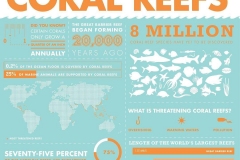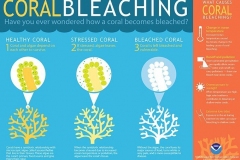Education




Understanding Coral Reef Ecosystems and the Dangers of Plastic Waste
Coral reefs are the most fragile ecosystems on our planet. They are ecological systems that include the stony boulder corals such as brain corals and star corals; branching corals such as staghorn and elkhorn corals; and soft corals such as sea fans and sea whips. But coral reef ecosystems are not only made-up of corals. They include sponges, and starfish, sea weeds, squids, sea cats (octopus), sea eggs (sea urchin), crabs – a great variety of reef fish – and in order to maintain good health and multiply they need clean unpolluted sea water.
These ecosystems are extremely complex and sensitive. Hard corals are living colonies of tiny animals that have a jelly-like outer surface. This surface is super sensitive. Imagine poking yourself in your eye with your own finger. That is how a coral feels when you touch it, or step on it! The other creatures, plants and algae, that live on the reef are sensitive too.
Corals can be easily damaged by discarded waste like plastic bags, fishing lines, plastic cups and cutlery – or choked or poisoned by micro-plastics that are too tiny to be seen by the naked eye.
Thus, coral reef ecosystems may be impacted by us. Every time we go for a swim, a snorkel, a dive, a party cruise on a boat, or a fishing trip, we need to be mindful our waste items don’t end up in the sea.
The coral reef ecosystems may also be impacted when we have a picnic on the beach, play games on the sand, or even by other activities that are much further away from the beach. Wind or rain can carry litter which is often made of plastic to the sea. We should take care not to litter.
So, we must be especially careful that our actions help to care for the coral reef ecosystems.
CORALL encourages everyone to bring re-usable or recyclable cups, plates and cutlery to their picnics, events and celebrations, as well as washable napkins and tea towels.
Those are some good ways to have No Problem. No Plastics.

There are three types of reefs; barrier reefs, fringing reefs and patch reefs.
A coral reef isn’t one ‘thing’, it’s actually a community of marine life that lives and thrives in one location. Reefs are where many fish and sea creatures choose to spawn. The protected environment of the reef means their eggs will be safe from predators.

Scientists have discovered that many parts of a coral reef can be harvested to make medications to treat cancers and other illnesses. Reefs grow where there are stronger wave patterns and currents. The stronger currents and waves deliver more food for the ecosystem that creates the reef structure.

CORALL Executive
President:
Damien Prescod
damien.prescod@gmail.com
Vice President:
Malakii Arthur
malakiiadarthur@gmail.com
Executive Treasurer:
Deborah Roach
corallmembershipandfundraising@gmail.com
Executive Secretary:











